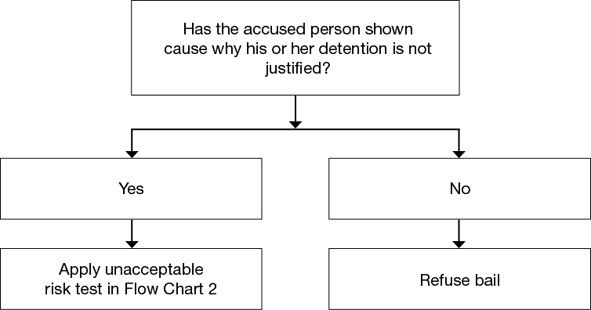changes to the bail act 2014

Background to Bail
The Bail Amendment Act 2014 (‘the Amending Act’), amending the Bail Act 2013 (NSW) (the ‘Act’) commenced on 28 January 2015. Arguably a result of growing public pressure, these amendments aim to strengthen the law surrounding bail in this State and to ensure that the key consideration and primary focus when determining bail is the risk of the offender to the community. The purpose of the Act is to provide the legislative framework for a decision as to whether a person who is accused of an offence or is otherwise required to appear before a court should be detained or released, with or without conditions. Bail is defined in s 7 of the Act as the authority to be at liberty for an offence. If a person is entitled to be at liberty for an offence, they are released from custody. This release and bail generally, is typically subject to conditions and requirements. One such condition is the requirement to appear outlined in s 13 of the Act - the person to whom bail is granted must attend Court when required to do so. The types of bail decisions that can be made, and by who, are outlined in s 8 of the Act, and are as follows:
The Amending Bail Act
key features of the Bail Amendment Act
A key feature of the Bail Amendment Act 2014 is the shifting of the burden of proof in the case of serious offences. The new Division 1A pertains to this requirement for an accused person to show cause for certain serious offences. There is no longer a presumption of innocence that the prosecution must waylay, and the onus on the defendant to show cause as to why there detention is not justified.
Under s 17 of the Act the bail authority must, when making a bail decision, assess any bail concerns. These are the concerns that an accused person will, if granted bail, do any of the following: fail to appear in Court, commit a serious offence, endanger victims, individuals or the community or interfere with witnesses or evidence. It is worth noting that this provision does not apply if an accused person has been refused bail as per Division 1A (discussed below). Matters to consider in this decision making process are listed in s 18 of the Act and include, but are not limited to things like: their background, including criminal history, the nature and seriousness of the offence, the strength of the prosecution case, and whether the accused person has any criminal associations.

New Division 1A – Show Cause Requirement
A key provision within the Amending Act is of course Division 1A – containing the show cause provision in s 16A and outlining the ‘show cause offences’ in s 16B. Those provisions have been provided in full below.
Rights of the accused?
These amendments have been met with arguments from some that these are reactive measures and that the amendments are contrary to the rights of defendants (who generally are yet to be found guilty of a crime). Bail is clearly an important feature of our legal system; it is also clearly something that should be treated very seriously. Holding someone in custody before they have been found guilty of a crime is not something that should be treated lightly, and to require that the accused show cause as to why they ought not be detained is perhaps against the “vibe” of the general principles of our criminal justice system.
Bail act Show Cause Requirement
(1) A bail authority making a bail decision for a show cause offence must refuse bail unless the accused person shows cause why his or her detention is not justified.
(2) If the accused person does show cause why his or her detention is not justified, them bail authority must make a bail decision in accordance with Division 2 (Unacceptable risk test-all offences).
(3) This section does not apply if the accused person was under the age of 18 years at the time of the offence.
16B Offences to which the show cause requirement applies
(1) For the purposes of this Act, each of the following offences is a "show cause offence":
(a) an offence that is punishable by imprisonment for life,
(b) a serious indictable offence that involves:
(i) sexual intercourse with a person under the age of 16 years by a person who is of or above the age of 18 years, or
(ii) the infliction of actual bodily harm with intent to have sexual intercourse with a person under the age of 16 years by a person who is of or above the age of 18 years,
(c) a serious personal violence offence, or an offence involving wounding or the infliction of grievous bodily harm, if the accused person has previously been convicted of a serious personal violence offence,
(d) any of the following offences:
(i) a serious indictable offence under Part 3 or 3A of the Crimes Act 1900or under the Firearms Act 1996that involves the use of a firearm,
(ii) an indictable offence that involves the unlawful possession of a pistol or prohibited firearm in a public place,
(iii) a serious indictable offence under the Firearms Act 1996that involves acquiring, supplying or manufacturing a pistol or prohibited firearm,
(e) any of the following offences:
(i) a serious indictable offence under Part 3 or 3A of the Crimes Act 1900or under the Weapons Prohibition Act 1998that involves the use of a military-style weapon,
(ii) an indictable offence that involves the unlawful possession of a military-style weapon,
(iii) a serious indictable offence under the Weapons Prohibition Act 1998that involves buying, selling or manufacturing a military-style weapon or selling, on 3 or more separate occasions, any prohibited weapon,
(f) an offence under the Drug Misuse and Trafficking Act 1985 that involves the cultivation, supply, possession, manufacture or production of a commercial quantity of a prohibited drug or prohibited plant within the meaning of that Act,
(g) an offence under Part 9.1 of the Criminal Code set out in the Schedule to the Criminal Code Act 1995of the Commonwealth that involves the possession, trafficking, cultivation, sale, manufacture, importation, exportation or supply of a commercial quantity of a serious drug within the meaning of that Code,
(h) a serious indictable offence that is committed by an accused person:
(i) while on bail, or
(ii) while on parole,
(i) an indictable offence, or an offence of failing to comply with a supervision order, committed by an accused person while subject to a supervision order,
(j) a serious indictable offence of attempting to commit an offence mentioned elsewhere in this section,
(k) a serious indictable offence (however described) of assisting, aiding, abetting, counselling, procuring, soliciting, being an accessory to, encouraging, inciting or conspiring to commit an offence mentioned elsewhere in this section.
(2) In this section, a reference to the facts or circumstances of an offence includes a reference to the alleged facts or circumstances of an offence. [Further definitions provided in s 16B(3)]
s 16 of the Act provides a useful flowchart: Flowchart 1 outlining the process by which the show cause requirement is met. This provision requires that the accused show just cause as to why their detention is not justified.
If the detention has been shown to be not justified, then the Court must apply the unacceptable risk test contained in Division 2 of the Act.
If the detention has not been shown by the accused to have been unjust, then bail will be refused. This means that in the case of certain serious offences, there is no second step involving gauging the risk of the accused, but instead a rebuttable presumption of refusal of bail.

Unacceptable Risk – all offences
If the accused under Division 1A has demonstrated that their detention is not justified, and in all other cases NOT involving show cause offences, the test for whether or not bail will be granted and/or on what conditions, is contained in Division 2 of the Act. In this Division, s 19 provides that
(1) A bail authority must refuse bail if the bail authority is satisfied, on the basis of an assessment of bail concerns under this Division, that there is an unacceptable risk.
(2) For the purposes of this Act, an "unacceptable risk" is an unacceptable risk that the accused person, if released from custody, will:
(a) fail to appear at any proceedings for the offence, or
(b) commit a serious offence, or
(c) endanger the safety of victims, individuals or the community, or
(d) interfere with witnesses or evidence.
(3) If the offence is a show cause offence, the fact that the accused person has shown cause that his or her detention is not justified is not relevant to the determination of whether or not there is an unacceptable risk.
(4) Bail cannot be refused for an offence for which there is a right to release under Division 2A.
This provision makes reference s 17 and s 18 of the Act, as previously discussed, pertaining to bail concerns and matters to be taken into consideration as part of the assessment of bail concerns.
The test then, is whether the accused person presents an unacceptable risk, having regard to the s 18 matters.
If yes, they will be refused bail.
If no, they may be released without bail, have bail dispensed with, or granted bail with conditions applied as per s 20A of the Act to address identified bail concerns (referring back to s 18 again).
Shown below is Flowchart 2 – Unacceptable Risk Test

Certain Offences have a Right to Release
Under s 21 of the Act, certain offences have what is called a ‘right to release’. This means that the only bail decisions that can be made in relation to those offences is basically that the accused person be released without bail, bail having been dispensed with, or bail granted with or without conditions – namely the person be released.
The offences with a right to release are listed in s 21(2) as being fine-only offences, an offence under the Summary Offences Act 1988 (other than those in a list of excluded offences) and an offence being dealt with by conference under pt 5 of the Young Offenders Act 1997. It is also important to note that under s 21(4) an offence is not an offence for which there is a right to release if the accused person has previously failed to comply with a bail acknowledgment, or a bail condition, of a bail decision for the offence.